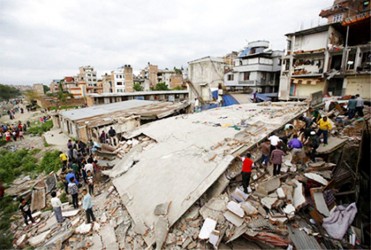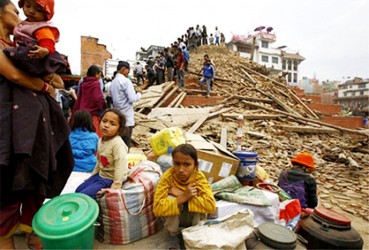KATHMANDU, (Reuters) – Thousands of desperate Nepalese huddled under tents and sought scarce food and medical supplies last night, two days after a massive quake killed more than 2,500 people, as overwhelmed authorities struggled to care for the wounded and homeless.
The sick and wounded lay out in the open in the capital, Kathmandu, unable to find beds in the devastated city’s hospitals. Surgeons set up an operating theatre inside a tent in the grounds of Kathmandu Medical College.
“We are overwhelmed with rescue and assistance requests from all across the country,” said Deepak Panda, a member of the country’s disaster management.

Across Kathmandu and beyond, exhausted families whose homes were either flattened or at risk of collapse laid mattresses out on streets and erected tents to shelter from rain.
People queued for water dispensed from the back of trucks, while the few stores still open had next to nothing on their shelves. Crowds jostled for medicine at one pharmacy.
High in the Himalayas, hundreds of foreign and Nepalese climbers remained trapped after a huge avalanche ripped through a base camp for climbers, killing 17 people in the worst single disaster to hit Mount Everest.
A total of 2,460 people were confirmed killed in the 7.9 magnitude quake, making it the worst such disaster to hit Nepal since 1934 when 8,500 died. Thousands more were injured.
Another 66 were killed across the border in India and at least another 20 in Tibet, China’s state news agency said, pushing the death toll beyond 2,500.
The toll is likely to climb as rescuers struggle to reach remote regions in the impoverished, mountainous country of 28 million people and as bodies buried under rubble are recovered.
With so many people sleeping in the open with no power or water and downpours forecast, fears mounted of major food and water shortages. Across Nepal, hundreds of villages have been left to fend for themselves.
Several countries rushed to send aid and personnel.
India flew in medical supplies and members of its National Disaster Response Force. China sent a 60-strong emergency team. Pakistan’s army said it was sending four C-130 airaft with a 30-bed hospital, search and rescue teams and relief supplies.
A Pentagon spokesman said a U.S. military aircraft with 70 personnel left the United States on Sunday and was due in Kathmandu today. Australia said it was sending a specialist urban search-and-rescue team to Kathmandu at Nepal’s request.
Britain, which believes several hundred of its nationals are in Nepal, said it was delivering supplies, medics and search-and-rescue teams.
However, there has been little sign of international assistance on the ground so far, with some aid flights prevented from landing by aftershocks that closed Kathmandu’s main airport several times on Sunday.

AVALANCHE TERRO
In the Himalayas, hundreds of climbers felt tremors yesterday powerful enough to send snow and boulders cascading towards them. Another was felt last night.
The huge and deadly avalanche on Saturday triggered by the earthquake caused panic at the Everest base camp, a sprawling “city” of tents from where mountaineers set off for the world’s highest peak.
“It was a monstrous sound, like the demons had descended on the mountain,” Khile Sherpa, a Nepalese guide, told Reuters, recalling the moment the avalanche hit.
He was one of the lucky few airlifted to the relative safety of Kathmandu but the disaster has underlined the woeful state of Nepal’s medical facilities.
Nepal has only 2.1 physicians and 50 hospital beds for every 10,000 people, according to a 2011 World Health Organization report.
“The earthquake has exposed that Nepal’s best public hospital infrastructure has crumbled at a time when it should serve more people in a hurry,” said Sarvendra Moongla, a senior surgeon at Bir Hospital’s Trauma Centre in Kathmandu, which opened in February.
At the Tribhuvan University Teaching Hospital, bodies, including that of a boy aged about seven, were heaped in a dark room. The stench of death was overpowering.
Outside, a 30-year-old woman who had been widowed wailed: “Oh Lord, why did you take him alone? Take me along with him.”
COUNTING THE COST
Rajiv Biswas, Asia Pacific chief economist at business research firm IHS, said long-term reconstruction costs in Nepal using proper building standards for an earthquake zone could be more than $5 billion, or around 20 percent of the country’s GDP.
“With housing construction standards in Nepal being extremely low … the impact of the earthquake has been devastating based on initial reports,” he said in an early analysis of the likely damage.
In crowded Kathmandu, many buildings were flattened or badly damaged.
Nepali army officer Santosh Nepal and a group of rescuers worked all night on Saturday to open a passage into a collapsed building in Kathmandu. They used pick axes because bulldozers could not get through the ancient city’s narrow streets.
“We believe there are still people trapped inside,” he told Reuters, pointing at concrete debris and twisted reinforcement rods where a three-storey residential building once stood.









